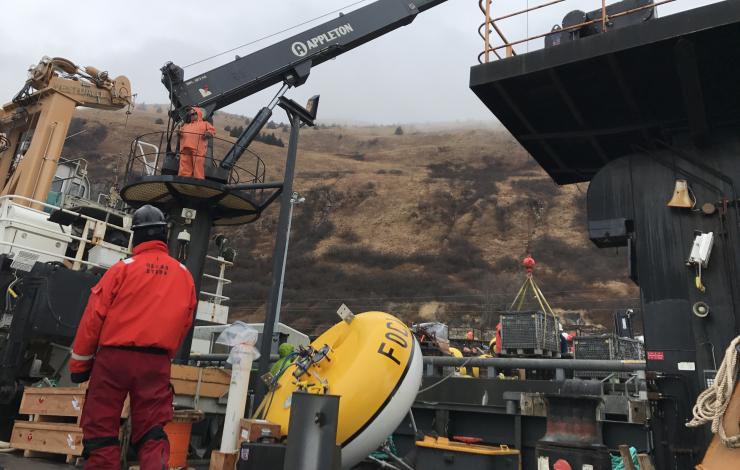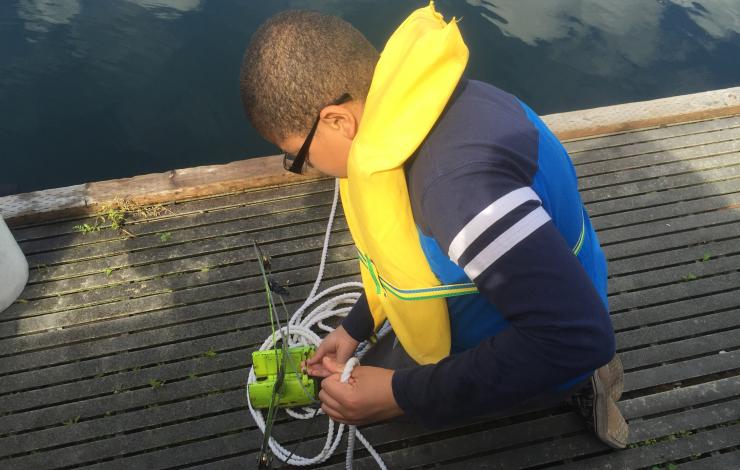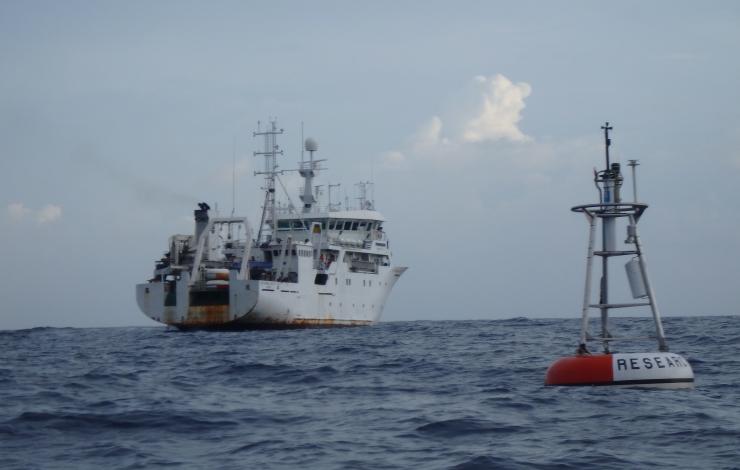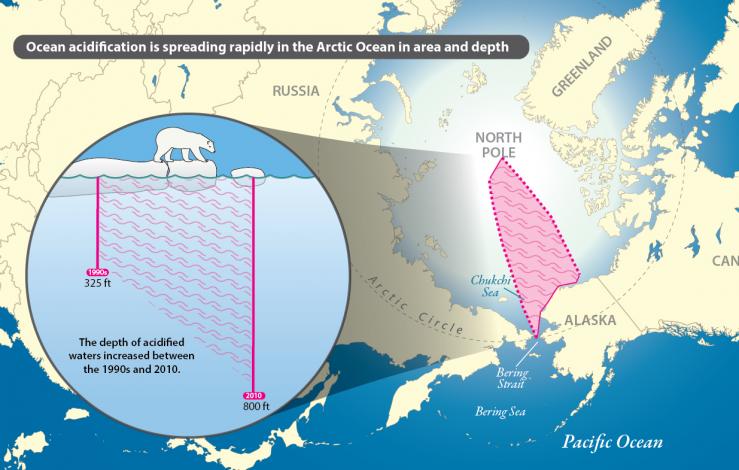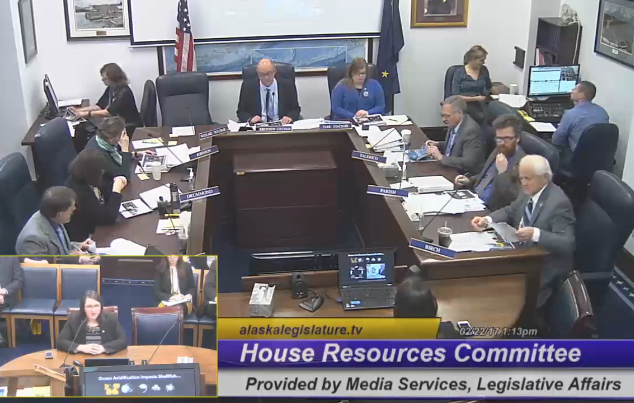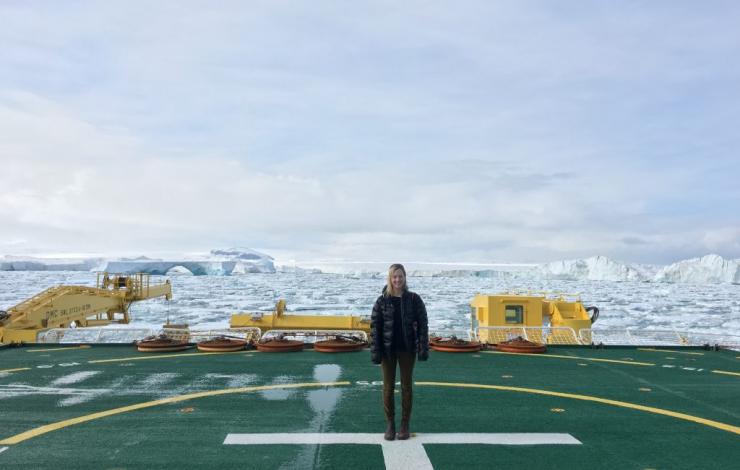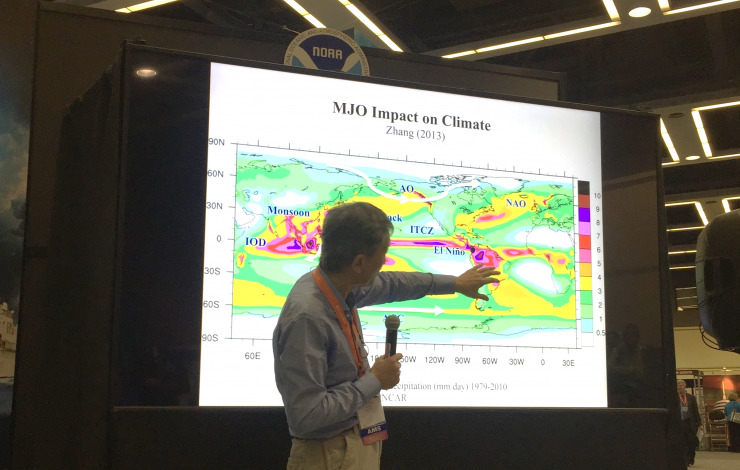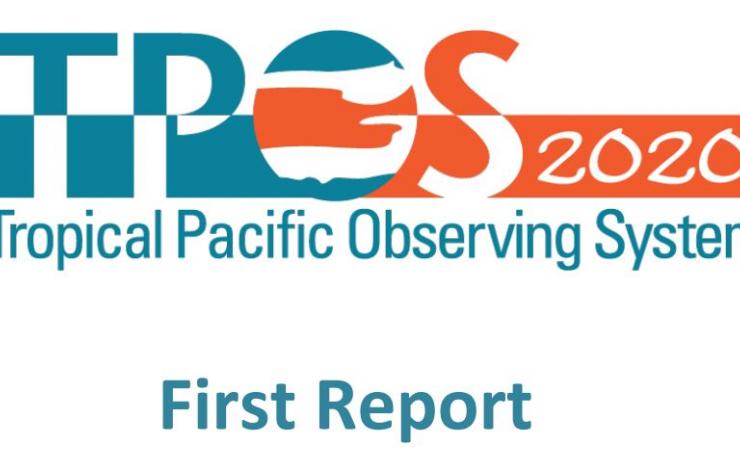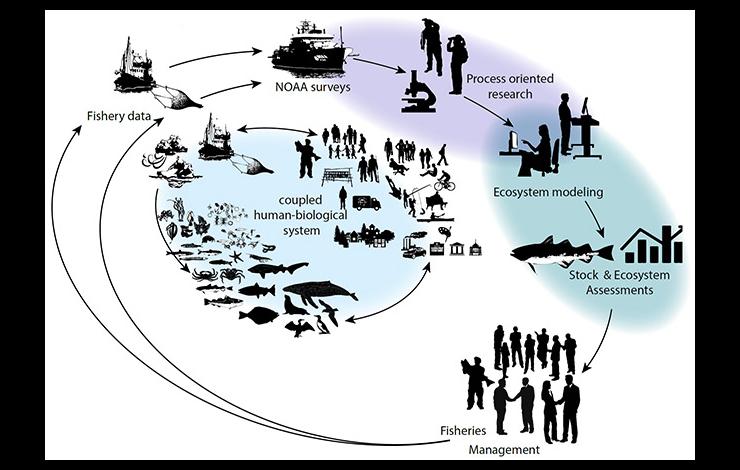What's New Archive
The EcoFOCI spring mooring cruise departed on Earth Day, April 22, from Kodiak, AK to service a biophysical mooring array in the Bering Sea, including M2. This is one of 11 research cruises the program will participate in from March-October. Aboard the NOAA research ship Oscar Dyson, scientists from PMEL, JISAO and AFSC are in Alaskan waters to retrieve and redeploy moorings, collect CTD (conductivity-temperature-depth) and other data. Peter Proctor from PMEL/JISAO is the Chief Scientist on the cruise and Geoff Lebon is the lead mooring scientist. The M2 mooring has been deployed in the southeastern Bering Sea for over 20 years and has been providing year-round measurements of temperature, salinity, nitrite, chlorophyll, and currents in this highly productive area. Long-term time-series at this site are a critical tool for adapting to climate change and guiding sustainable management of living resources in the Bering Sea.
EcoFOCI will also be field testing and using several technologies in collaboration with PMEL’s Innovative Technology for Arctic Exploration program; including the Prawler, Oculus and Acrobat Towed Vehicle. These technologies enhance shipboard and mooring research with more data collection over a fine scale region.
The EcoFOCI program is a collaborative research effort by scientists at the Pacific Marine Environmental Lab (PMEL) and Alaska Fisheries Science Center (AFSC) focusing on the unique and economically important high-latitude ecosystems of Alaska. Learn more about the program here.
Registration for 2017 NOAA Science Camp is now open! NOAA Science Camp is held at the NOAA Campus in Seattle, WA and introduces both middle and high school students to the diverse range of careers and research conducted by our scientists. Three programs are offered: Middle School Science Camp, High School Junior Leadership Program and a Remotely Operated Vehicle Mini Session. PMEL scientists (NOAA and JISAO) lead activities relating to engineering and oceanography, including how scientists conduct their research when they go to sea, how scientists work with engineers to solve complex marine questions, how currents and trace chemicals move throughout the ocean, and even how buoys help predict large-scale climate events such as Tsunamis. The camps will run at various times from July 10-26.
The middle school camp offers two sessions: July 10-14 and July 17-21, 2017. NOAA Science Camp has partnered again with Atlantis STEAM to offer a three-day mini-session where campers will get to design, build, and drive their own Remotely Operated Vehicles (ROVs). This is an exciting addition to our summer programming - please check out the website and register for this session being offered on July 24-26, 2017. Look for the green registration button on each page to register your camper.
Learn more on the Washington Sea Grant site and register for NOAA Science Camp here.
PMEL’s Global Tropical Moored Buoy Array group has begun the 2017 field season of the Research Moored Array for African-Asian-Australian Monsoon Analysis and Prediction (RAMA) in the Indian Ocean.
PMEL scientists and engineers just finished participating in the collaborative US-Indonesian research cruise aboard the Indonesian research vessel Baruna Jaya VIII in support of the RAMA array. Dr. Michael McPhaden, Tim Nesseth, and William Higley (from the University of Washington’s Joint Institute for the Study of the Ocean and Atmosphere) serviced 5 RAMA moorings along 90°E. The cruise left Jakarta on February 20 and returned to Jakarta on March 16 with a mid-cruise port call in Sabang on northern Sumatra. During the mid-cruise port stop in Mike McPhaden briefed local and regional officials from the Indonesian Agency for Meteorology, Climatology, and Geophysics (BMKG), which partners with NOAA in maintaining RAMA buoys in the eastern Indian Ocean.
RAMA is an international effort to improve understanding and ability to predict of the African-Asian-Australian monsoon system. It complements other moored arrays in the Atlantic (PIRATA) and Pacific (TAO/TRITON) Oceans. Since RAMA began in 2004, the array has since grown through the formation of new partnerships and is now 78% complete. To learn more about RAMA, visit PMEL’s Global Tropical Moored Buoy Array’s website here.
New research published today in Nature Climate Change shows that ocean acidification is spreading rapidly in the western Arctic Ocean in both area and depth, potentially harming shellfish, other marine species in the food web and people who depend on these resources.
This research shows that between 1994 and 2010, acidified waters expanded northward approximately 300 nautical miles from the Chukchi Sea slope off the coast of northwestern Alaska to just below the North Pole. Also, the depth of acidified waters increased from approximately 325 feet to over 800 feet (or from 100 to 250 meters). The international research team determined the saturation state for aragonite, a carbonate mineral that marine organisms need to build shells, from water samples taken in the Arctic during cruises by the Chinese ice breaker XueLong (meaning “snow dragon”) in the summers 2008 and 2010, and during three other cruises. This research results showed that the Arctic Ocean is undergoing a rapid and large-scale increase in acidification, at least twice as fast as that observed in the Pacific or Atlantic oceans.
NOAA PMEL’s Richard Feely is a co-author on the paper led by China’s Key Laboratory of Global Change and Marine-Atmospheric Chemistry of State Ocean Administration, Xiamen, China, and the University of Delaware.
Read more on NOAA.gov and the University of Delaware's Press Release here. Learn more about PMEL’s Carbon Program on their website here.
Read the paper in Nature Climate Change here.
On February 22, 2017, Dr. Jessica Cross gave an invited presentation on ocean acidification and its potential impacts to fisheries and natural resources in Alaska to the Alaska State Legislature’s House Resources Committee. Dr. Cross was invited by Rep. Geran Tarr, Co-Chair of the House Resources Committee. The presentation covered impacts on food security and risk assessment for Alaska's fishery sector. Future projections of OA indicate imminent impacts on the Bristol Bay Red King Crab fishery, according to NOAA researchers in OAR and NMFS at the Alaska Fisheries Science Center. While in Juneau, Jessica also gave a talk to the University of Alaska, and the United Fishermen of Alaska (UFA). The Alaska Ocean Acidification Network facilitated these discussions as a way of connecting scientists like Dr. Cross to stakeholders, like UFA, and regulators at the state legislature. The Network brings together these diverse groups to identify knowledge gaps and information needs for future research and community resilience.
Dr. Cross' current research focuses on carbon biogeochemistry and ocean acidification in Arctic regions, especially along the Alaskan coast. Learn more about her work with the Innovative Technology for Arctic Exploration Group here.
From January 21 - March 2, Lauren Roche from the PMEL Acoustics Program will be aboard the R/V Araon deploying six hydrophones (shown in the image below in the Ross Sea, Antarctica. The objective of this research cruise is to use various land- and ship-based research methods to gain a thorough understanding of the Terra Nova Bay region. The PMEL Acoustics Program has been collaborating with the Korea Polar Research Institute (KOPRI) for several years on multiple projects in Antarctica. On this research cruise, Lauren will be replacing a hydrophone triad near the Drygalski Ice Tongue that was deployed last year as well as deploying a second triad in a new location further north. The data collected from these deployments will allow the Acoustics program to characterize the soundscape of the Terra Nova Bay polynya.
On February 8, Lauren successfully recovered hydrophones that likely recorded the Nansen glacier calving event. Read more about the event and the Nansen ice shelf here: http://www.esa.int/Our_Activities/Observing_the_Earth/Copernicus/Sentinel-1/Nansen_gives_birth_to_two_icebergs
Lauren Roche is a new mooring technician with PMEL Acoustics Program through Oregon State University’s Cooperative Institute for Marine Resources Studies (CIMRS). Her background is in bioacoustics and fisheries and will be deploying, recovering, and building the hydrophones for the group. Learn more about the acoustics program here.
Last week, PMEL scientists attended the American Meteorological Society (AMS)’s Annual Meeting in Seattle, WA and the Alaska Marine Science Symposium (AMSS) in Anchorage, AK. Presentations covered research in the Bering Sea, data management and access, El Nino, sea ice, the Earth's energy imbalance, innovative technologies, and recent warming in the Pacific and others.
At AMSS, the Ecosystems and Fisheries-Oceanography Coordinated Investigations (EcoFOCI) group had multiple presentations and posters on the Bering Sea including topics on the recent marine heat wave in Alaska, linking annual oceanographic processes to contiguous ecological domains in the pacific Arctic, fish distributions, ecology, Saildrone and oceanography.
A wider range of topics were covered at AMS and included invited talks from Nick Bond, Chidong Zhang and Kevin Wood. Dr. Zhang spoke about the Dynamics of the Madden-Julian Oscillation; Kevin Wood presented the Old Weather Project using historical U.S. ship logbooks to collect and analyze historical climate data; and Nick Bond discussed the recent warming in the NE Pacific. The annual meeting is the world’s largest yearly gathering for the weather, water, and climate community and brings together atmospheric scientists, professionals, students, educators and research’s from around the world. AMS is the nation’s premier scientific and professional organization promoting and disseminating information about the atmospheric, oceanic, hydrologic sciences.
Learn more about all our different research themes and groups here.
The final version of the TPOS 2020 First Report is now available on the TPOS2020 website. The report rethinks the Tropical Pacific Observing System from top to bottom. It rises to the challenge of once-in-a-generation opportunity. The report provides initial recommendations and actions that begin a process of transformation and change to an observing system that will be more capable, resilient and effective. The report provides more than 20 recommendations for the observing system and key actions for implementation. One of the key recommendations include reconfiguring the moored array with more capable moorings, targeting the equatorial circulation, the mixed layer and its interaction with the atmosphere, and key regimes.
The scientific and sponsoring members of the TPOS 2020 aim to rejuvenate and revamp the Tropical Pacific Observing System (TPOS) to meet the observational, experimental, and operational needs of today and the future. The purpose of the TPOS 2020 project is oversee the transition to a more resilient and integrated observing system to meet the identified gaps as well as future needs as they are identified
NOAA Fisheries and its partners, including the Pacific Marine Environmental Laboratory, released Regional Action Plans (RAPs) on December 16th, to guide implementation of the NOAA Fisheries Climate Science Strategy in each region (Northeast, Southeast, Gulf of Mexico, Alaska, Western, Pacific Islands). Ecosystems and Fisheries Oceanography Coordinated Investigations (EcoFOCI) program lead Phyllis Stabeno (PMEL) and Janet Duffy-Anderson (AFSC) were co-authors on the Alaska Regional Report. The Alaska Fisheries Science Center and the Pacific Marine Environmental Laboratory have the scientific infrastructure needed to produce the analyses and deliver benchmarks for the eastern Bering Sea.
This Regional Action Plan identifies key actions to address priority information needs over the next five years to better understand, prepare for and respond to climate changes in the Bering Sea ecosystem. The Regional Action Plan, part of the NOAA Fisheries Climate Science Strategy, focuses on seven science objectives.
Alaska's fisheries are worth $1.8 billion and are vital to local economies and our country's food supply. Alaska is also at the front lines of a changing marine environment. To protect and maintain the region's resources, fishermen, lawmakers and other decision-makers need information to respond to these changes and protect livelihoods and traditional cultures.The Regional Action Plan will help Alaskan communities, commercial and recreational fishermen and others who are dependent on Alaskan marine resources respond and adapt to changes that may be ahead in response to a changing climate and help ensure the sustainability of these marine resources.
Read plan highlights here.
Read the full report in the NOAA Fisheries scientific publication, Technical Memorandum.
Learn about Regional Action Plans from across the country, here.
PMEL scientists, including scientists from the University of Washington's Joint Institute for the Study of the Ocean and Atmosphere (JISAO) and Oregon State University's Cooperative Institute for Marine Resources Studies (CIMRS) are attending the American Geophysical Union (AGU)’s Annual Meeting in San Francisco this week, December 12-16. AGU's Falling Meeting is the largest Earth and space science meeting in the world bringing together the Earth and space science community for discussions of emerging trends and the latest research. Poster and talk topics include data integration, El Nino Southern Oscillation (ENSO), Indian Ocean temperature trends, hydrothermal plumes and vents, carbon dioxide in the tropics and Gulf of Alaska, aerosol research, and heat impacts on marine ecosystems and fisheries, tsunamis, and acoustic research.
The 2016 Arctic Report Card will be released Tuesday morning in conjunction with a press conference led by NOAA’s Jeremy Mathis. The 2016 Arctic Report Card brings together the work of 61 scientists from 11 nations to provide the latest information on multiple measures of Arctic environmental change, including air and sea surface temperature, sea ice, snow cover, vegetation, wildlife, and plankton abundance. Read the full report and highlights here as well as the press release. Watch the recorded press conference here.
Researchers will also present during a press conference Thursday morning some of the first scientific results from the 2015 Axial Seamount eruption including discoveries of previously unknown structures and new glimpses into the volcano’s internal plumbing. These new insights into the world’s most active and well-studied underwater volcano may help scientists better understand all volcanoes and the hazards they pose. Read the press release here. Watched the recorded press conference here.
Dr. Bob Embley from the Earth-Ocean Interactions group will be honored during the Awards Ceremony as part of the 2016 class of Fellows for his pioneering contributions to the understanding of deep-sea volcanism by fostering interdisciplinary investigations with advanced technologies.



